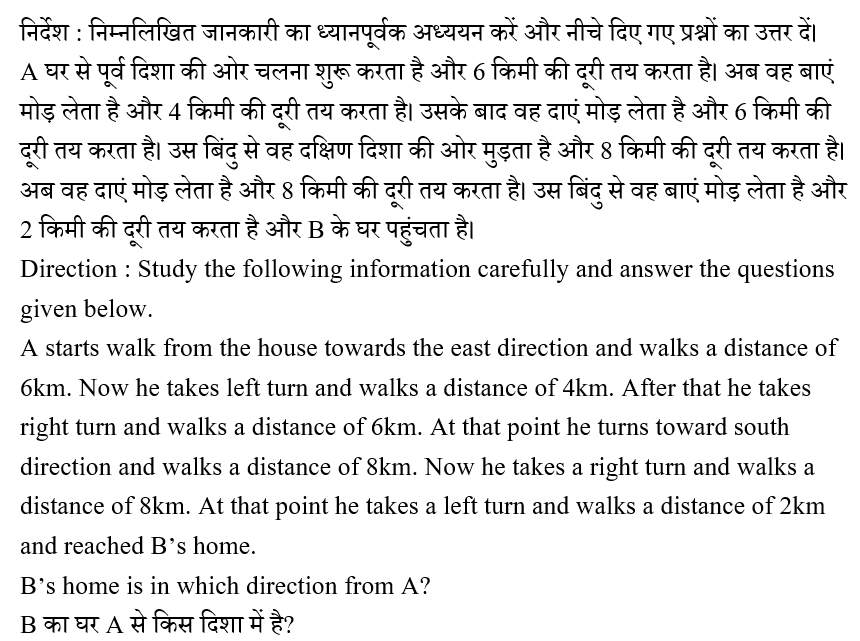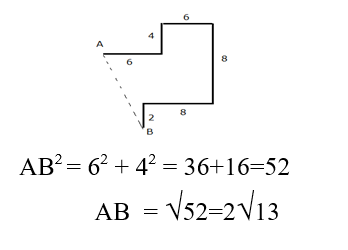Question 1: 
Question 2: 
Question 3: 
Question 4: 
Question 5:
If it is possible to make it only one meaningful word from the third, fourth, sixth and seventh letter of the word TRANSMISSION, then the last letter of the word is your answer. If no such word can be formed Z is your answer and if more than one word can be formed Y is your answer.
यदि TRANSMISSION शब्द के तीसरे, चौथे, छठे और सातवें अक्षर से केवल एक सार्थक शब्द बनाना संभव है, तो शब्द का अंतिम अक्षर आपका उत्तर है। यदि ऐसा कोई शब्द नहीं बनाया जा सकता है तो Z आपका उत्तर है और यदि एक से अधिक शब्द बन सकते हैं तो Y आपका उत्तर है।
Question 6:
निर्देश : निम्नलिखित जानकारी सावधानी से पढ़ें और नीचे दिए गए प्रश्नों का उत्तर दें।
Direction: Study the following information carefully and answer the below questions.
आठ सन्दुक - A1, B1, C1, D2, A2, B2, C3 और D4 एक दूसरे से ऊपर रखे गए हैं। प्रत्येक सन्दुक में विभिन्न मोबाइल फोन हैं जैसे कि एचटीसी, ऐप्पल, सैमसंग, माइक्रोसॉफ्ट, लेनोवो, सोनी, विवो और माइक्रोमैक्स लेकिन जरूरी नहीं उसी क्रम में है।
C3 के ऊपर के सन्दुक की संख्या, इसके नीचे संदूकों की संख्या से एक कम है। लेनोवो और सोनी के बीच केवल दो सन्दुक हैं। लेनोवो वाला सन्दुक या तो C3 के तुरंत ऊपर या तुरंत नीचे रखा गया है। सैमसंग वाला सन्दुक, लेनोवो वाले सन्दुक के ऊपर किसी एक स्थान पर रखा गया है। सैमसंग वाला सन्दुक शीर्ष स्थान पर नहीं रखा गया है। सैमसंग वाले सन्दुक के ऊपर रखे संदूकों की संख्या, माइक्रोसॉफ्ट वाले सन्दुक के नीचे रखे संदूकों की संख्या के बराबर है। D2 और D4 के बीच तीन सन्दुक हैं; सन्दुक D2 में सैमसंग नहीं है और शीर्ष स्थान पर नहीं रखा गया है। सन्दुक D2, सन्दुक D4 से ऊपर रखा गया है। सन्दुक A1 में ऐप्पल है और इसे B2 से तुरंत ऊपर रखा गया है। सन्दुक C1 में माइक्रोमैक्स है और सन्दुक A1 के ऊपर किसी एक स्थान पर रखा गया है। विवो वाला सन्दुक या तो निम्नतम या शीर्षतम स्थान पर रखा गया है। सन्दुक A2, सन्दुक C3 के ऊपर किसी एक स्थान पर रखा गया है। सन्दुक B1 में न तो लेनोवो और न ही सैमसंग है।
There are eight boxes namely– A1, B1, C1, D2, A2, B2, C3 and D4 are placed one above another. Each box contains different mobile phones viz. HTC, Apple, Samsung, Microsoft, Lenovo, Sony, Vivo and Micromax but not necessarily in same order.
The number of boxes above C3 is one less than the number of boxes below it. There are only two boxes placed between Lenovo and Sony. The box with Lenovo is placed either immediately above or immediately below C3. The box with Samsung is placed at one of the positions above the box with Lenovo. The box with Samsung is not placed at the topmost position. Number of boxes placed above the box with Samsung is as same the number of boxes placed below the box with Microsoft. There are three boxes between D2 and D4; the box D2 doesn’t have Samsung and is not placed at the topmost position. The box D2 is placed above D4. The box A1 contains Apple and is placed immediately above B2. The C1 box contains Micromax and is placed at one of the positions above A1 box. The box with Vivo is placed at either lowermost or topmost position. The box A2 is placed at one of the positions above the box C3. The box B1 contains neither Lenovo nor Samsung.
Which of the following box has Vivo mobiles?
निम्नलिखित में से कौन सा सन्दुक में विवो मोबाइल है?
Question 7:
निर्देश : निम्नलिखित जानकारी सावधानी से पढ़ें और नीचे दिए गए प्रश्नों का उत्तर दें।
Direction: Study the following information carefully and answer the below questions.
आठ सन्दुक - A1, B1, C1, D2, A2, B2, C3 और D4 एक दूसरे से ऊपर रखे गए हैं। प्रत्येक सन्दुक में विभिन्न मोबाइल फोन हैं जैसे कि एचटीसी, ऐप्पल, सैमसंग, माइक्रोसॉफ्ट, लेनोवो, सोनी, विवो और माइक्रोमैक्स लेकिन जरूरी नहीं उसी क्रम में है।
C3 के ऊपर के सन्दुक की संख्या, इसके नीचे संदूकों की संख्या से एक कम है। लेनोवो और सोनी के बीच केवल दो सन्दुक हैं। लेनोवो वाला सन्दुक या तो C3 के तुरंत ऊपर या तुरंत नीचे रखा गया है। सैमसंग वाला सन्दुक, लेनोवो वाले सन्दुक के ऊपर किसी एक स्थान पर रखा गया है। सैमसंग वाला सन्दुक शीर्ष स्थान पर नहीं रखा गया है। सैमसंग वाले सन्दुक के ऊपर रखे संदूकों की संख्या, माइक्रोसॉफ्ट वाले सन्दुक के नीचे रखे संदूकों की संख्या के बराबर है। D2 और D4 के बीच तीन सन्दुक हैं; सन्दुक D2 में सैमसंग नहीं है और शीर्ष स्थान पर नहीं रखा गया है। सन्दुक D2, सन्दुक D4 से ऊपर रखा गया है। सन्दुक A1 में ऐप्पल है और इसे B2 से तुरंत ऊपर रखा गया है। सन्दुक C1 में माइक्रोमैक्स है और सन्दुक A1 के ऊपर किसी एक स्थान पर रखा गया है। विवो वाला सन्दुक या तो निम्नतम या शीर्षतम स्थान पर रखा गया है। सन्दुक A2, सन्दुक C3 के ऊपर किसी एक स्थान पर रखा गया है। सन्दुक B1 में न तो लेनोवो और न ही सैमसंग है।
There are eight boxes namely– A1, B1, C1, D2, A2, B2, C3 and D4 are placed one above another. Each box contains different mobile phones viz. HTC, Apple, Samsung, Microsoft, Lenovo, Sony, Vivo and Micromax but not necessarily in same order.
The number of boxes above C3 is one less than the number of boxes below it. There are only two boxes placed between Lenovo and Sony. The box with Lenovo is placed either immediately above or immediately below C3. The box with Samsung is placed at one of the positions above the box with Lenovo. The box with Samsung is not placed at the topmost position. Number of boxes placed above the box with Samsung is as same the number of boxes placed below the box with Microsoft. There are three boxes between D2 and D4; the box D2 doesn’t have Samsung and is not placed at the topmost position. The box D2 is placed above D4. The box A1 contains Apple and is placed immediately above B2. The C1 box contains Micromax and is placed at one of the positions above A1 box. The box with Vivo is placed at either lowermost or topmost position. The box A2 is placed at one of the positions above the box C3. The box B1 contains neither Lenovo nor Samsung.
Which of the following box is placed fourth from the bottom?
निम्नलिखित में से कौन सा सन्दुक नीचे से चौथे स्थान पर रखा गया है?
Question 8:
निर्देश : निम्नलिखित जानकारी सावधानी से पढ़ें और नीचे दिए गए प्रश्नों का उत्तर दें।
Direction: Study the following information carefully and answer the below questions.
आठ सन्दुक - A1, B1, C1, D2, A2, B2, C3 और D4 एक दूसरे से ऊपर रखे गए हैं। प्रत्येक सन्दुक में विभिन्न मोबाइल फोन हैं जैसे कि एचटीसी, ऐप्पल, सैमसंग, माइक्रोसॉफ्ट, लेनोवो, सोनी, विवो और माइक्रोमैक्स लेकिन जरूरी नहीं उसी क्रम में है।
C3 के ऊपर के सन्दुक की संख्या, इसके नीचे संदूकों की संख्या से एक कम है। लेनोवो और सोनी के बीच केवल दो सन्दुक हैं। लेनोवो वाला सन्दुक या तो C3 के तुरंत ऊपर या तुरंत नीचे रखा गया है। सैमसंग वाला सन्दुक, लेनोवो वाले सन्दुक के ऊपर किसी एक स्थान पर रखा गया है। सैमसंग वाला सन्दुक शीर्ष स्थान पर नहीं रखा गया है। सैमसंग वाले सन्दुक के ऊपर रखे संदूकों की संख्या, माइक्रोसॉफ्ट वाले सन्दुक के नीचे रखे संदूकों की संख्या के बराबर है। D2 और D4 के बीच तीन सन्दुक हैं; सन्दुक D2 में सैमसंग नहीं है और शीर्ष स्थान पर नहीं रखा गया है। सन्दुक D2, सन्दुक D4 से ऊपर रखा गया है। सन्दुक A1 में ऐप्पल है और इसे B2 से तुरंत ऊपर रखा गया है। सन्दुक C1 में माइक्रोमैक्स है और सन्दुक A1 के ऊपर किसी एक स्थान पर रखा गया है। विवो वाला सन्दुक या तो निम्नतम या शीर्षतम स्थान पर रखा गया है। सन्दुक A2, सन्दुक C3 के ऊपर किसी एक स्थान पर रखा गया है। सन्दुक B1 में न तो लेनोवो और न ही सैमसंग है।
There are eight boxes namely– A1, B1, C1, D2, A2, B2, C3 and D4 are placed one above another. Each box contains different mobile phones viz. HTC, Apple, Samsung, Microsoft, Lenovo, Sony, Vivo and Micromax but not necessarily in same order.
The number of boxes above C3 is one less than the number of boxes below it. There are only two boxes placed between Lenovo and Sony. The box with Lenovo is placed either immediately above or immediately below C3. The box with Samsung is placed at one of the positions above the box with Lenovo. The box with Samsung is not placed at the topmost position. Number of boxes placed above the box with Samsung is as same the number of boxes placed below the box with Microsoft. There are three boxes between D2 and D4; the box D2 doesn’t have Samsung and is not placed at the topmost position. The box D2 is placed above D4. The box A1 contains Apple and is placed immediately above B2. The C1 box contains Micromax and is placed at one of the positions above A1 box. The box with Vivo is placed at either lowermost or topmost position. The box A2 is placed at one of the positions above the box C3. The box B1 contains neither Lenovo nor Samsung.
What is the position of the box which has Sony mobiles?
सोनी मोबाइल के सन्दुक की स्थिति क्या है?
Question 9:
निर्देश : निम्नलिखित जानकारी सावधानी से पढ़ें और नीचे दिए गए प्रश्नों का उत्तर दें।
Direction: Study the following information carefully and answer the below questions.
आठ सन्दुक - A1, B1, C1, D2, A2, B2, C3 और D4 एक दूसरे से ऊपर रखे गए हैं। प्रत्येक सन्दुक में विभिन्न मोबाइल फोन हैं जैसे कि एचटीसी, ऐप्पल, सैमसंग, माइक्रोसॉफ्ट, लेनोवो, सोनी, विवो और माइक्रोमैक्स लेकिन जरूरी नहीं उसी क्रम में है।
C3 के ऊपर के सन्दुक की संख्या, इसके नीचे संदूकों की संख्या से एक कम है। लेनोवो और सोनी के बीच केवल दो सन्दुक हैं। लेनोवो वाला सन्दुक या तो C3 के तुरंत ऊपर या तुरंत नीचे रखा गया है। सैमसंग वाला सन्दुक, लेनोवो वाले सन्दुक के ऊपर किसी एक स्थान पर रखा गया है। सैमसंग वाला सन्दुक शीर्ष स्थान पर नहीं रखा गया है। सैमसंग वाले सन्दुक के ऊपर रखे संदूकों की संख्या, माइक्रोसॉफ्ट वाले सन्दुक के नीचे रखे संदूकों की संख्या के बराबर है। D2 और D4 के बीच तीन सन्दुक हैं; सन्दुक D2 में सैमसंग नहीं है और शीर्ष स्थान पर नहीं रखा गया है। सन्दुक D2, सन्दुक D4 से ऊपर रखा गया है। सन्दुक A1 में ऐप्पल है और इसे B2 से तुरंत ऊपर रखा गया है। सन्दुक C1 में माइक्रोमैक्स है और सन्दुक A1 के ऊपर किसी एक स्थान पर रखा गया है। विवो वाला सन्दुक या तो निम्नतम या शीर्षतम स्थान पर रखा गया है। सन्दुक A2, सन्दुक C3 के ऊपर किसी एक स्थान पर रखा गया है। सन्दुक B1 में न तो लेनोवो और न ही सैमसंग है।
There are eight boxes namely– A1, B1, C1, D2, A2, B2, C3 and D4 are placed one above another. Each box contains different mobile phones viz. HTC, Apple, Samsung, Microsoft, Lenovo, Sony, Vivo and Micromax but not necessarily in same order.
The number of boxes above C3 is one less than the number of boxes below it. There are only two boxes placed between Lenovo and Sony. The box with Lenovo is placed either immediately above or immediately below C3. The box with Samsung is placed at one of the positions above the box with Lenovo. The box with Samsung is not placed at the topmost position. Number of boxes placed above the box with Samsung is as same the number of boxes placed below the box with Microsoft. There are three boxes between D2 and D4; the box D2 doesn’t have Samsung and is not placed at the topmost position. The box D2 is placed above D4. The box A1 contains Apple and is placed immediately above B2. The C1 box contains Micromax and is placed at one of the positions above A1 box. The box with Vivo is placed at either lowermost or topmost position. The box A2 is placed at one of the positions above the box C3. The box B1 contains neither Lenovo nor Samsung.
If the Box C1 is related to Lenovo; Box A1 is related to Microsoft in a certain way. Then which of the following mobile does C3 is related to?
यदि एक निश्चित तरीके से सन्दुक C1, लेनोवो से संबंधित है; सन्दुक A1, माइक्रोसॉफ्ट से संबंधित है। तो निम्नलिखित में से कौन सा मोबाइल C3 से संबंधित है?
Question 10:
निर्देश : निम्नलिखित जानकारी सावधानी से पढ़ें और नीचे दिए गए प्रश्नों का उत्तर दें।
Direction: Study the following information carefully and answer the below questions.
आठ सन्दुक - A1, B1, C1, D2, A2, B2, C3 और D4 एक दूसरे से ऊपर रखे गए हैं। प्रत्येक सन्दुक में विभिन्न मोबाइल फोन हैं जैसे कि एचटीसी, ऐप्पल, सैमसंग, माइक्रोसॉफ्ट, लेनोवो, सोनी, विवो और माइक्रोमैक्स लेकिन जरूरी नहीं उसी क्रम में है।
C3 के ऊपर के सन्दुक की संख्या, इसके नीचे संदूकों की संख्या से एक कम है। लेनोवो और सोनी के बीच केवल दो सन्दुक हैं। लेनोवो वाला सन्दुक या तो C3 के तुरंत ऊपर या तुरंत नीचे रखा गया है। सैमसंग वाला सन्दुक, लेनोवो वाले सन्दुक के ऊपर किसी एक स्थान पर रखा गया है। सैमसंग वाला सन्दुक शीर्ष स्थान पर नहीं रखा गया है। सैमसंग वाले सन्दुक के ऊपर रखे संदूकों की संख्या, माइक्रोसॉफ्ट वाले सन्दुक के नीचे रखे संदूकों की संख्या के बराबर है। D2 और D4 के बीच तीन सन्दुक हैं; सन्दुक D2 में सैमसंग नहीं है और शीर्ष स्थान पर नहीं रखा गया है। सन्दुक D2, सन्दुक D4 से ऊपर रखा गया है। सन्दुक A1 में ऐप्पल है और इसे B2 से तुरंत ऊपर रखा गया है। सन्दुक C1 में माइक्रोमैक्स है और सन्दुक A1 के ऊपर किसी एक स्थान पर रखा गया है। विवो वाला सन्दुक या तो निम्नतम या शीर्षतम स्थान पर रखा गया है। सन्दुक A2, सन्दुक C3 के ऊपर किसी एक स्थान पर रखा गया है। सन्दुक B1 में न तो लेनोवो और न ही सैमसंग है।
There are eight boxes namely– A1, B1, C1, D2, A2, B2, C3 and D4 are placed one above another. Each box contains different mobile phones viz. HTC, Apple, Samsung, Microsoft, Lenovo, Sony, Vivo and Micromax but not necessarily in same order.
The number of boxes above C3 is one less than the number of boxes below it. There are only two boxes placed between Lenovo and Sony. The box with Lenovo is placed either immediately above or immediately below C3. The box with Samsung is placed at one of the positions above the box with Lenovo. The box with Samsung is not placed at the topmost position. Number of boxes placed above the box with Samsung is as same the number of boxes placed below the box with Microsoft. There are three boxes between D2 and D4; the box D2 doesn’t have Samsung and is not placed at the topmost position. The box D2 is placed above D4. The box A1 contains Apple and is placed immediately above B2. The C1 box contains Micromax and is placed at one of the positions above A1 box. The box with Vivo is placed at either lowermost or topmost position. The box A2 is placed at one of the positions above the box C3. The box B1 contains neither Lenovo nor Samsung.
How many boxes are there between the boxes which has Microsoft and Micro max?
माइक्रोसॉफ्ट और माइक्रोमैक्स के सन्दुक के बीच कितने सन्दुक हैं?










